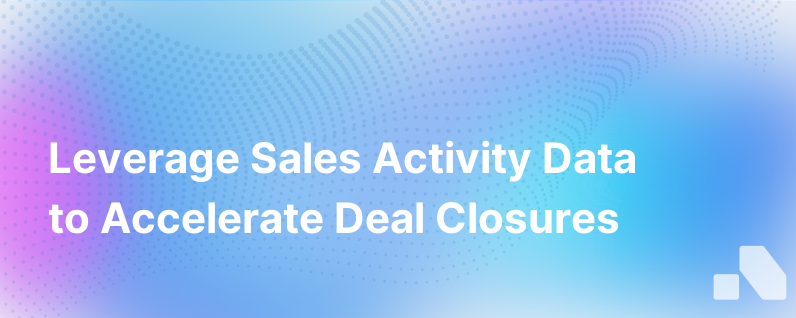3 Strategic Ways To Use Sales Activity Data To Accelerate Deals
Published on January 9, 2024 by David Zhang
In today's competitive business environment, leveraging sales activity data can be the key differentiator in accelerating deal closures. With a plethora of touchpoints from emails and phone calls to social engagements and meetings, sales activity data is rich with insights—if you know how to use it strategically. Here are three time-tested strategies that enable sales teams to make data-driven decisions that accelerate deals through the pipeline.
Strategy 1: Optimizing Sales Engagement
Prioritize with Precision
The starting point for optimizing sales engagement is to understand which activities are driving deals forward. Sales leaders should analyze historical data to identify patterns that lead to closed-won deals. Questions to consider include:
- At what stage do prospects typically become more responsive?
- What types of communication (calls, emails, demos) correlate with movement in the pipeline?
- How many touches, on average, does it take to move a prospect from one stage to the next?
By answering these questions, sales teams can develop a playbook that prioritizes high-impact sales activities over less productive ones. This ensures that your reps are spending their valuable time on targeted actions that are known to accelerate the sales process.
Tailor Interactions for Maximum Impact
Every prospect is unique, and a one-size-fits-all approach can hinder the pace of a deal. Sales activity data enables reps to tailor their interactions to meet the specific needs and preferences of each prospect:
- Analyze which communication channels yield the highest response rates and preference those in future engagements.
- Identify content types (e.g., case studies, whitepapers, video demos) that have a history of influencing prospects and integrate them into your touchpoints.
- Review timing and frequency of past successful interactions to determine the best cadence for follow-ups.
Customizing engagements based on historical data can significantly improve the relevance and impact of your sales interactions, thereby moving the needle on deals.
Strategy 2: Fine-tuning the Sales Process
Streamline the Follow-up Sequence
A prompt and structured follow-up sequence is critical to keep prospects engaged and prevent deals from stalling. Use sales activity data to refine this sequence:
- Calculate the sweet spot for follow-up timing based on historical deal flow data.
- Develop standardized templates for follow-up communications aligned with stages of the buyer's journey.
- Create automated reminders and tasks in your CRM to ensure no follow-up opportunities are missed.
This systematic approach, informed by data, ensures that follow-ups are meaningful, timely, and conducive to advancing the sales process.
Sharpen the Lead Qualification Framework
With the right data, sales teams can revamp their lead qualification methods to focus on high probability leads first, thereby accelerating potential deal closings:
- Analyze demographic, firmographic, and behavioral data to refine lead scoring models.
- Revisit criteria for Marketing Qualified Leads (MQLs) and Sales Qualified Leads (SQLs) to ensure they align with data on what characteristics indicate a ready-to-buy prospect.
- Regularly review and adjust qualification processes based on conversion rate data to maintain alignment with evolving market conditions.
Improving your lead qualification with data-driven insights enables your sales team to spend more time on leads that are more likely to convert, thus speeding up the sales cycle.
Strategy 3: Enhancing Sales Training and Coaching
Develop Targeted Training Programs
By dissecting sales activity data, sales leaders can identify knowledge or skill gaps and create tailored training programs:
- Determine which stages of the pipeline present the most significant challenges for reps, and develop targeted training to improve performance in those areas.
- Monitor which reps are excelling and encourage them to share their best practices with the team.
- Employ data to inform role-playing scenarios and other training exercises that are directly related to the sales activities that influence deal progression.
Effective training, driven by data, equips reps with the practical skills they need to engage more effectively with prospects and close deals faster.
Personalize Coaching and Feedback
Data doesn't just inform what your team should do—it can also be an essential tool in coaching and developing your reps:
- Use analytics to identify specific strengths and weaknesses of individual sales reps, tailoring coaching accordingly.
- Review recorded sales calls and demos for teachable moments, using real-life examples to reinforce best practices and dissect missed opportunities.
- Implement data-triggered coaching, where reps receive automated tips or coaching interventions based on their activity data patterns.
Personalized coaching that leverages sales activity data reinforces behaviors that lead to faster deal closures and helps reps overcome personal obstacles to success.
Conclusion
Ultimately, sales activity data is much more than just a series of numbers and charts. When harnessed effectively, it is a treasure trove of insights that can strategically drive every aspect of your sales operations. Employing these data-driven strategies not only accelerates deal closures but also contributes to the continuous optimization of your sales processes, leading to greater efficiency and increased revenue. By embedding these strategies into your team's routine, you essentially set the stage for a smarter, quicker, and more successful sales operation.
In the ever-evolving landscape of B2B sales, empowering your sales team with the right tools and insights can be transformative. Platforms like Aomni leverage the power of AI to effortlessly harness and interpret sales data, ensuring strategies are consistently optimized to keep your sales cycle moving swiftly. With such technology, businesses are well-equipped to not just understand their sales activity data but to act on it, accelerating their path to successful deal closures.